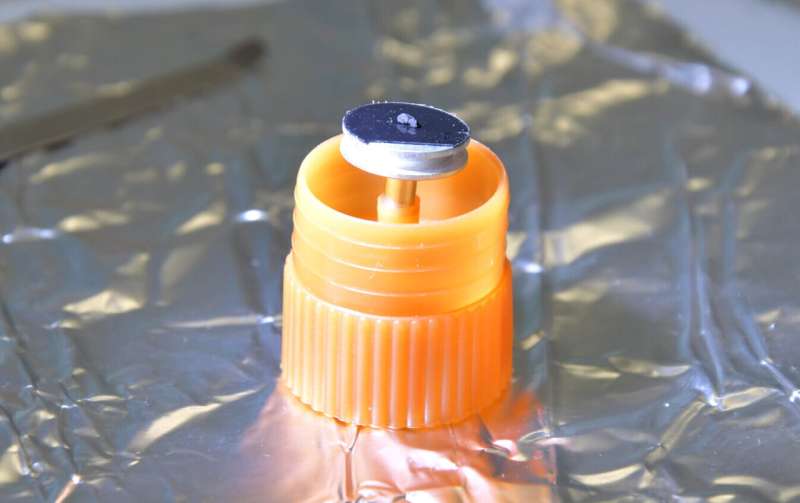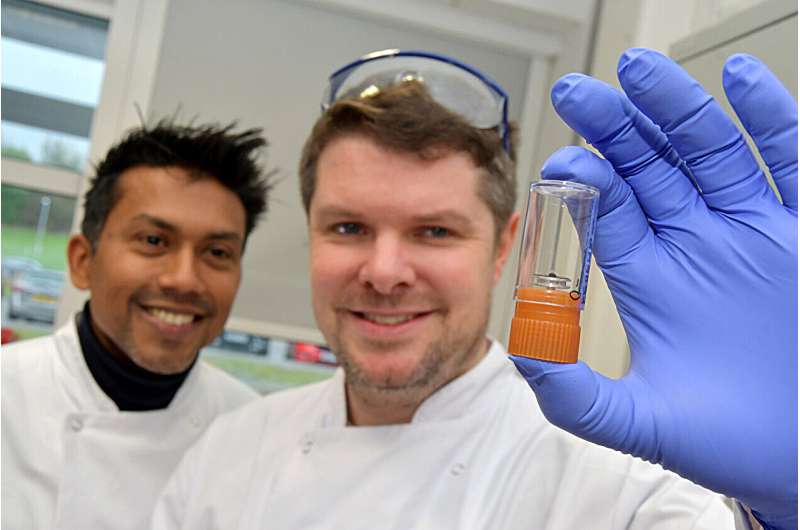This article has been reviewed according to Science X's editorial process and policies. Editors have highlighted the following attributes while ensuring the content's credibility:
fact-checked
trusted source
proofread
Possible first ever synchrotron-based analysis of asteroid Bennu to be performed

After an amazing journey, a grain from the asteroid Bennu will be brought to Diamond Light Source, the UK's national synchrotron, for scientific measurements. The grain is from 100 milligrams of sample sent to the Natual History Museum (NHM) in London, a small fraction of the approximately 70 grams of Bennu rock and dust brought back by NASA's OSIRIS-REx mission. It will be subject to intensive analysis at the Dual Imaging And Diffraction (DIAD) instrument in Diamond by Dr. Ashley King and his team from the NHM and other OSIRIS-REx collaborators at the Open, Oxford and Manchester Universities.
The DIAD beamline at Diamond is a one-of-a-kind scientific instrument that can extract chemical composition information and enable virtual dissection at an unprecedented level of detail, non-destructively. This will provide a wealth of scientific data and new knowledge about the asteroid, and the origins of our solar system.
The Origins, Spectral Interpretation, Resource Identification, and Security-Regolith Explorer (OSIRIS-REx) spacecraft launched to the near-Earth asteroid Bennu on Sept. 8, 2016. In October 2020, it collected a sample of rocks and dust from Bennu's surface, 330 million km (205 million miles) from Earth. The material, collected by the NASA mission, took almost three years to be returned to Earth (Utah desert, U.S.) on Sept. 24, 2023.
Dr. Ashley King, a planetary scientist from the Natural History Museum, specializes in using synchrotron techniques to examine samples that are literally out of this world. He has previously studied meteorite samples at Diamond. He will use this knowledge and the museum's extensive mineral and meteorite collections in the study to enable the research team to make sample comparisons and have standards to help with the calculations.

Dr. King was part of the group who put first eyes and instruments on the rocky samples from asteroid Bennu and examined them in a specially designed laboratory at NASA Johnson Space Center in Texas. This initial analysis showed the black, extraterrestrial powder to be rich in carbon and water-laden minerals, something Dr. King is excited to verify using the DIAD instrument at Diamond.
He comments, "Although this sample is small, only a little larger than a grain of sand, it is more than enough to reveal a lot of information about our solar system. Diamond is key as it enables non-destructive testing of the samples, which is vital. The Bennu samples will be used to test theories that suggest asteroids like Bennu may have been involved in delivering key components to the young Earth system some 4.5 billion years ago.
"Potentially, it's how we got the water in our oceans and some of the compounds that were necessary to kick-start life. Our experiments are focused on understanding the mineralogy, composition and textures of the samples to be able to tell the story of Bennu's history. Using DIAD, we'll be able to explore the mineralogy of Bennu in 3D."
Dr. Sharif Ahmed, Principal Beamline Scientist on Diamond's Dual Imaging And Diffraction (DIAD) beamline, adds, "What sets DIAD apart is its unique ability to measure the chemical composition and 3D internal structure of the sample at the same time and location. We achieve this by combining X-ray powder diffraction and X-ray computed tomography, which enables DIAD to extract information that no other instrument can. We are super excited about being one of the first instruments in the world to analyze a piece of Bennu. I cannot wait to see what insight DIAD reveals."
DIAD is a dual beam X-ray instrument for imaging, diffraction and scattering, which enables scientists to investigate the internal 2D- and 3D-microstructure of complex, dynamic structures (with imaging) as well as local phase and strain information (from diffraction) on the micron scale.
Prof Gianluigi Botton, CEO of Diamond Light Source, concludes, "It is amazing to think that these samples have come all the way from the asteroid through a feat of engineering that got the OSIRIS-REx mission to be such a success. Next, it's wonderful to see our scientists be able to play their part in this important worldwide collaboration. The teams involved believe that this research will accelerate our understanding of how planets formed and how life itself began as asteroids are considered the building blocks of our solar system."
The OSIRIS-REx teams aim to complete a raft of studies in time to report at the Lunar and Planetary Science Conference (LPSC) in March 2024. Two major overview papers are also expected to be published in the journal Meteoritics & Planetary Science.
Provided by Diamond Light Source





















